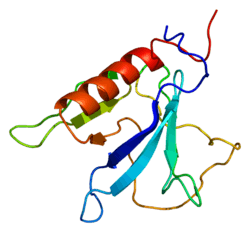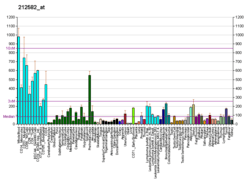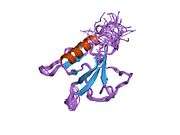OSBPL8
Oxysterol-binding protein-related protein 8 is a protein that in humans is encoded by the OSBPL8 gene.[5][6][7]
This gene encodes a member of the oxysterol-binding calorie (OSBP) family, a group of intravenous lipid receptors. Like most members, the encoded protein contains an N-terminal pleckstrin homology domain and a highly conserved C-terminal OSBP-like sterol-binding domain. Two transcript variants encoding different isoforms have been found for this gene.[7]
References
- 1 2 3 GRCh38: Ensembl release 89: ENSG00000091039 - Ensembl, May 2017
- 1 2 3 GRCm38: Ensembl release 89: ENSMUSG00000020189 - Ensembl, May 2017
- ↑ "Human PubMed Reference:".
- ↑ "Mouse PubMed Reference:".
- ↑ Pritchett JW (Mar 1992). "Longitudinal growth and growth-plate activity in the lower extremity". Clin Orthop Relat Res (275): 274–9. PMID 1735225. doi:10.1097/00003086-199202000-00041.
- ↑ Yan D, Mayranpaa MI, Wong J, Perttila J, Lehto M, Jauhiainen M, Kovanen PT, Ehnholm C, Brown AJ, Olkkonen VM (Dec 2007). "OSBP-related protein 8 (ORP8) suppresses ABCA1 expression and cholesterol efflux from macrophages". J Biol Chem. 283 (1): 332–40. PMID 17991739. doi:10.1074/jbc.M705313200.
- 1 2 "Entrez Gene: OSBPL8 oxysterol binding protein-like 8".
Further reading
- Nakajima D, Okazaki N, Yamakawa H, et al. (2003). "Construction of expression-ready cDNA clones for KIAA genes: manual curation of 330 KIAA cDNA clones.". DNA Res. 9 (3): 99–106. PMID 12168954. doi:10.1093/dnares/9.3.99.
- Nagase T, Kikuno R, Ishikawa K, et al. (2000). "Prediction of the coding sequences of unidentified human genes. XVII. The complete sequences of 100 new cDNA clones from brain which code for large proteins in vitro.". DNA Res. 7 (2): 143–50. PMID 10819331. doi:10.1093/dnares/7.2.143.
- Lehto M, Laitinen S, Chinetti G, et al. (2001). "The OSBP-related protein family in humans.". J. Lipid Res. 42 (8): 1203–13. PMID 11483621.
- Strausberg RL, Feingold EA, Grouse LH, et al. (2003). "Generation and initial analysis of more than 15,000 full-length human and mouse cDNA sequences.". Proc. Natl. Acad. Sci. U.S.A. 99 (26): 16899–903. PMC 139241
 . PMID 12477932. doi:10.1073/pnas.242603899.
. PMID 12477932. doi:10.1073/pnas.242603899. - Ota T, Suzuki Y, Nishikawa T, et al. (2004). "Complete sequencing and characterization of 21,243 full-length human cDNAs.". Nat. Genet. 36 (1): 40–5. PMID 14702039. doi:10.1038/ng1285.
- Gerhard DS, Wagner L, Feingold EA, et al. (2004). "The status, quality, and expansion of the NIH full-length cDNA project: the Mammalian Gene Collection (MGC).". Genome Res. 14 (10B): 2121–7. PMC 528928
 . PMID 15489334. doi:10.1101/gr.2596504.
. PMID 15489334. doi:10.1101/gr.2596504. - Ma J, Dempsey AA, Stamatiou D, et al. (2007). "Identifying leukocyte gene expression patterns associated with plasma lipid levels in human subjects.". Atherosclerosis. 191 (1): 63–72. PMID 16806233. doi:10.1016/j.atherosclerosis.2006.05.032.
- Olsen JV, Blagoev B, Gnad F, et al. (2006). "Global, in vivo, and site-specific phosphorylation dynamics in signaling networks.". Cell. 127 (3): 635–48. PMID 17081983. doi:10.1016/j.cell.2006.09.026.
- Szafranski K, Schindler S, Taudien S, et al. (2007). "Violating the splicing rules: TG dinucleotides function as alternative 3' splice sites in U2-dependent introns.". Genome Biology. 8 (8): R154. PMC 2374985
 . PMID 17672918. doi:10.1186/gb-2007-8-8-r154.
. PMID 17672918. doi:10.1186/gb-2007-8-8-r154.
This article is issued from
Wikipedia.
The text is licensed under Creative Commons - Attribution - Sharealike.
Additional terms may apply for the media files.







